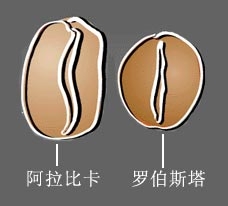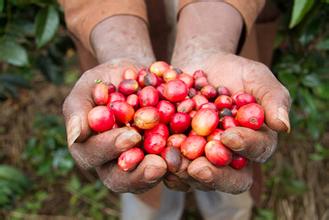How can Robusta beans tell? Robusta's skill in selecting standard and distinguishing Robbstadt beans
The picture compares the shape difference between Arabica and Robusta coffee beans.


The appearance of Arabica coffee beans is quite obvious compared with that of Robusta coffee beans. Arabica coffee is long, flat, complete and greenish; robusta coffee is round, thicker and whiter.
Busta coffee tree is a kind of tree between shrubs and tall trees, with long leaves, bright green leaves, up to 10 meters tall, but shallow roots, slightly rounder and smaller fruit than Arabica coffee, with flat beans and straight tattoos in the middle.
"Robusta" coffee, commonly known as "sturdy beans", can be grown at low elevations (200 to 800 meters above sea level), has strong resistance to diseases and insect pests, is not vulnerable to agricultural disasters, has a high annual output per unit area, and is harvested in large quantities by machine. in general, the cost of production is much lower than that of Arabica coffee.
"Robusta" coffee usually has an ordinary, rigid and pungent flavor, and because the vast majority of robusta around the world are grown in low-altitude areas (author's note: as of May 2008, only India has rare high-altitude, high-quality, washed Robusta coffee beans). The flavor produced by different regions and different climates is not very different, relatively lack of personality. When unbaked, it smells like raw peanuts, and the taste of cheap robusta coffee beans is usually between "wheat tea" (light baking) and "rubber tire flavor" (deep roasting). It is difficult to show a meticulous flavor.
Asia is the home of robusta coffee. There are six largest exporters of robusta coffee in the world and three in Asia, accounting for 2% and 3% of the world's output. Compared with other regions, Asia has more gains and losses, not only in terms of price, but also in the image of Robusta coffee. India has great potential to influence these factors. Some of the new producers I mentioned earlier, Laos, Cambodia, Nepal and Myanmar, will only be competitive in the market and have a small reputation if their production becomes noticeable. As the world consumes more and more ground coffee. Robusta Coffee will have great potential for the diversity of ground coffee.
The article comes from the Internet.
Important Notice :
前街咖啡 FrontStreet Coffee has moved to new addredd:
FrontStreet Coffee Address: 315,Donghua East Road,GuangZhou
Tel:020 38364473
- Prev

Introduction to hand-brewing coffee sharing how to learn how to brew hand-brewed coffee
For many friends who have just come into contact with hand-brewed coffee, a major problem may be: in the beginner stage, the seemingly simple hand-brewing pot suddenly becomes heavy in the hand, and the flow regulation is not as comfortable as it seems. Water injection for a long time will also tremble, unable to control the flow of these, on the one hand, because
- Next

Introduction of Uganda Coffee producing area introduction of Uganda Robusta beans
Mbale on the eastern side of the Elgang Mountains and other producing areas on the western side near the border of the Democratic Republic of the Congo have the export name Wugar. The official ranks are Oaganic (Organic), BugisuAA, BugisuA, BugisuB, Bugisu PB, Wugar, Drugar and other unlisted grades. To find a good Ugandan coffee, you must first identify BugisuAA, An and P
Related
- Beginners will see the "Coffee pull flower" guide!
- What is the difference between ice blog purified milk and ordinary milk coffee?
- Why is the Philippines the largest producer of crops in Liberia?
- For coffee extraction, should the fine powder be retained?
- How does extracted espresso fill pressed powder? How much strength does it take to press the powder?
- How to make jasmine cold extract coffee? Is the jasmine + latte good?
- Will this little toy really make the coffee taste better? How does Lily Drip affect coffee extraction?
- Will the action of slapping the filter cup also affect coffee extraction?
- What's the difference between powder-to-water ratio and powder-to-liquid ratio?
- What is the Ethiopian local species? What does it have to do with Heirloom native species?

